

» Ayn Rand
« Practice makes perfect, but it doesn’t make new. » Adam Grant. Read This If You Feel Like You Can’t Stop Creating Problems In Your Mind. Our brains are designed to worry, and they’re good at it.
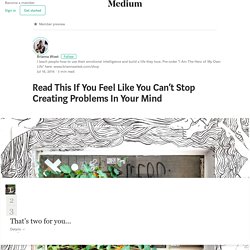
They’re built to determine the next big thing to “fix.” This is a great thing. It is because of this cognitive feature that we have evolved the way we have. We developed every major industry (agriculture, medicine, religion) out of some kind of fear. Death, disorder, starvation, meaninglessness. So if you feel like you can’t stop worrying, can’t stop creating problems for yourself, shift your anxiety from one corner of your life to the next, can’t just sit back and enjoy and be grateful and happy, it’s not because there’s something wrong with you. We weren’t built to be “happy” in the way that we think of happiness — carefree, grateful, excited.
We were born to survive, which is to create. Suffering dissolves when we focus on creating rather than feeling. Good and bad become irrelevant when the focus isn’t “what can I enjoy” but “what can I create?” Obstacles become opportunities. Everything is creative. You Don't Have to Be a Genius to Be Creative. Are you a creative person?

Chances are, you said you aren’t. We’ve been conditioned to believe that creativity is the sole domain of geniuses, a kind of divine inspiration that is beyond the reach of ordinary people. But the common perception of creativity is largely based on myth and legend. Allen Gannett, CEO of TrackMaven and author of “The Creative Curve: How to Develop the Right Idea at the Right Time,” dug into the science and history of creative achievement and found a surprising pattern.
Could Getting Messy Improve Your Creativity? Do you wish you were more creative?
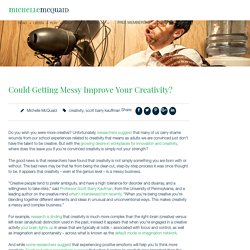
Unfortunately, researchers suggest that many of us carry shame wounds from our school experiences related to creativity that means as adults we are convinced just don’t have the talent to be creative. But with the growing desire in workplaces for innovation and creativity, where does this leave you if you’re convinced creativity is simply not your strength?
Tapping Into the Daily Rituals of Our Great Creative Minds. History can teach us a lot about the way we work today.

Benjamin Franklin rigorously planned and segmented his daily routine in an effort to accomplish good each day. Thomas Edison used an epic to-do list to fuel his prolific innovation and inventions. Out of superstition, Tchaikovsky took a daily two-hour walk. His return was timed precisely: not a minute early, not a minute late. Mason Currey, author of Daily Rituals: How Artists Work, researched and profiled 161 artists, composers, philosophers, playwrights, scientists, writers, and poets. We recently spoke with Mason about the work rituals and routines of great creative minds. We all start each day on equal footing. 6 Famous Artists Talk About What It’s Like to Overcome Fear and Create Beauty.
Long before I was publishing articles for the world to read, I wrote in a private document.

I did this for more than a year. The Pain of Creating. Posted on 28 Jan | 1 comment I have wanted to be a writer for as long as I can remember.
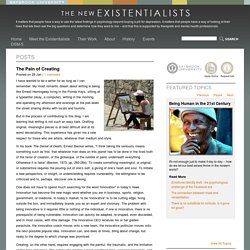
My most romantic dream about writing is being like Ernest Hemingway living in the Florida Keys, sitting at a typewriter (okay, a computer), writing in the morning, and spending my afternoon and evenings at the pub down the street sharing drinks with locals and tourists. But in the process of contributing to this blog, I am learning that writing is not such an easy task.
Drafting original, meaningful pieces is at best difficult and at its worst devastating. This experience has given me a new respect for those who are artists, whatever their medium and style. In his book The Denial of Death, Ernest Becker writes, “I think taking life seriously means something such as this: that whatever man does on this planet has to be done in the lived truth of the terror of creation, of the grotesque, of the rumble of panic underneath everything. References Becker, E. (1973). May, R. (1975). -- Steve Fehl.
Imagination. Test Anxiety. Sublimation. Self-Achievement. SCAMPER a creative thinking technique. How to Solve Difficult Problems by Using the Inversion Technique. Imagine the most important goal or project you are working on right now.
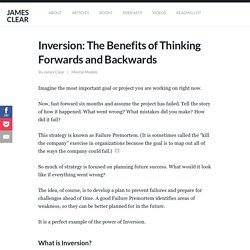
Now, fast forward six months and assume the project has failed. Tell the story of how it happened. What went wrong? What mistakes did you make? How did it fail? This strategy is known as Failure Premortem. So much of strategy is focused on planning future success. Creative People Say No. A Hungarian psychology professor once wrote to famous creators asking them to be interviewed for a book he was writing.
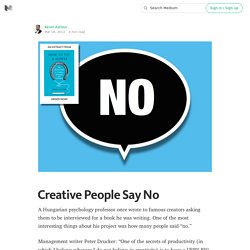
One of the most interesting things about his project was how many people said “no.” Management writer Peter Drucker: “One of the secrets of productivity (in which I believe whereas I do not believe in creativity) is to have a VERY BIG waste paper basket to take care of ALL invitations such as yours — productivity in my experience consists of NOT doing anything that helps the work of other people but to spend all one’s time on the work the Good Lord has fitted one to do, and to do well.” Secretary to novelist Saul Bellow: “Mr Bellow informed me that he remains creative in the second half of life, at least in part, because he does not allow himself to be a part of other people’s ‘studies.’ ” Photographer Richard Avedon: “Sorry — too little time left.”
Design Thinking. Creative Therapy. Journaling. Regeneration.